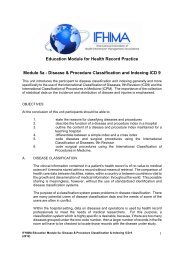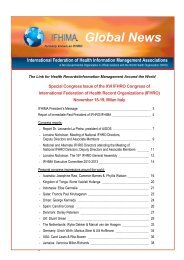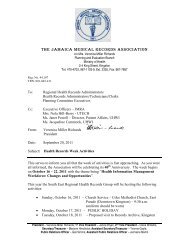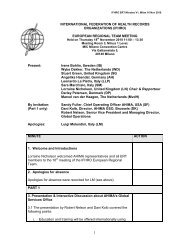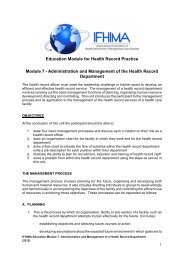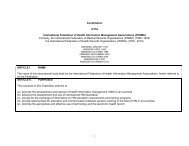Learning Packages for Medical Record Practice - ifhima
Learning Packages for Medical Record Practice - ifhima
Learning Packages for Medical Record Practice - ifhima
Create successful ePaper yourself
Turn your PDF publications into a flip-book with our unique Google optimized e-Paper software.
number be assigned. It requires the use of a MPI to cross-reference the<br />
patient’s name with his or her health record number.<br />
There are two main systems of numbering patient records:<br />
a.<br />
b.<br />
• Serial numbering<br />
• Unit numbering<br />
Serial numbering<br />
With this method the patient receives a new health record number on<br />
every inpatient admission or outpatient visit to the hospital or clinic. That<br />
is, the patient is treated as a new patient each time with a new number,<br />
new index card and new record, filed totally independently from previous<br />
records.<br />
Serial numbering is not used extensively today and is only useful in small<br />
hospitals with a low rate of readmission.<br />
Unit numbering<br />
The patient is assigned a unique identification number on his first contact<br />
with the hospital, whether it is <strong>for</strong> an admission, emergency room or<br />
outpatient clinic visit.<br />
The same health record number is kept and used on all subsequent visits,<br />
whether as an inpatient, outpatient or emergency patient. A unit health<br />
record number results in the creation of one, central health record <strong>for</strong> the<br />
patient.<br />
This number is normally related to one single record, where all the<br />
in<strong>for</strong>mation on the patient is brought together. These data can originate<br />
from different clinics or units, at different time periods. If a unit record is<br />
not possible, the unit numbering system can be used to link health<br />
records that are physically located in different places.<br />
1) The advantages of using a unit number <strong>for</strong> filing are:<br />
� the number is unique to the individual and there<strong>for</strong>e distinguishes<br />
him/her from any other patient in the hospital or clinic<br />
� the number does not change regardless of how often a person is<br />
admitted to hospital or attends a clinic<br />
� patients' health records are centralized in a single folder<br />
� this system provides the medical staff with a complete picture of<br />
the patient's medical history and treatment received over a<br />
number of admissions and attendances.<br />
IFHIMA Education Module 3: <strong>Record</strong> Identification Systems, Filing and Retention of Health <strong>Record</strong>s<br />
(2012)<br />
3



